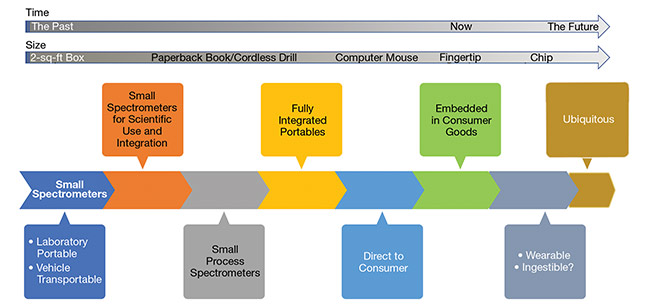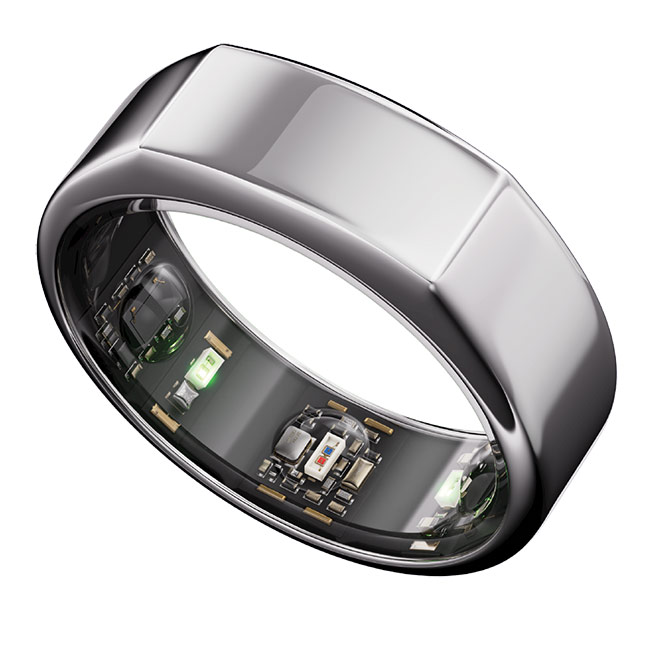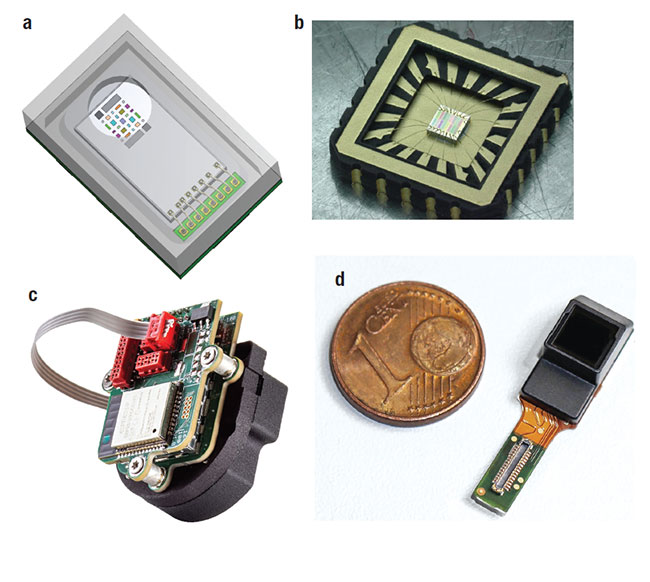RICHARD CROCOMBE, CROCOMBE SPECTROSCOPIC CONSULTING
We are about to see the next step in portable spectroscopy as optical spectrometers and multispectral sensors increasingly appear in consumer goods, all the way from washing machines and vacuum cleaners to smoke detectors, smartphones, and wearables such as sports watches. These sensors may not be immediately obvious to the consumer, but they deliver intelligence to optimize product operation or to inform consumers about their health. Spectroscopy is becoming pervasive.
Portable spectrometers
Traditional portable optical spectrometers are available across the spectrum, from UV-VIS to near-infrared, mid-infrared, and also Raman spectrometers1. These portable instruments have been engineered to perform as complete analytical systems, for specific purposes — for instance, to analyze water in the UV-VIS region and grain in the near-infrared, and to identify suspicious and potentially hazardous materials using mid-infrared and Raman spectroscopy.
Two spectral regions have attracted considerable development: the visible and shortwave near-infrared regions covered by silicon detectors (~400 to 1000 nm) — sometimes designated as VNIR — and the near-infrared region covered by indium gallium arsenide (InGaAs) and lead salt (PbS [lead sulfide] and PbSe [lead selenide]) detectors (1000 to 2500 nm).
The VNIR region has been of particular interest because silicon-based detectors are relatively inexpensive. In the range from 400 to 700 nm, we are obviously sensing color. In the 700- to 1000-nm region, we can detect the third and fourth overtone vibrational bands from molecules with C-H, N-H, and O-H bonds to deliver specific molecular information. These vibrational bands are weak. However, the weak radiation penetrates deeper into the material, increasing the sample, which is desirable for analyzing heterogeneous materials. For example, this region is used for quantitative analysis of grain.
More specific chemical information is available in the 1000- to 2500-nm region, which is commonly used in applications such as food analysis, material identification for recycling, and raw material chemical identification in chemical and pharmaceutical manufacturing.
The size of instruments, especially in the visible and near-infrared regions, has diminished steadily over the years, from the familiar 2-sq-ft beige boxes in laboratories to instruments the size of cordless drills and bricks, to those the size of a computer mouse. This evolution is shown in Figure 1.

Figure 1. The evolution in the size of small spectrometers, from 2-sq-ft boxes to chips.
More recently, the industry has delivered spectrographs and spectra sensors that are fingertip-size or smaller, with a concomitant reduction in cost, making spectroscopic devices attractive for incorporation into consumer goods. Product designers have found significant benefits to embedding a spectrometer, multispectral sensor, and/or other photonic components into consumer goods. The table below lists spectrometer-enabled products that either have been commercially launched or soon will be.
Multispectral sensors come into play
In condensed phases (solids and liquids), the width of bands in the visible region can be very large, typically 50 to 100 nm.
In the near-infrared, bands in natural product spectra are similarly broad, while those of pure chemicals and polymers are narrower, typically 5 to 10 nm. Therefore, an instrument with a small number of resolution elements can perform routine analyses, and spectral range is more relevant than spectral resolution.

Incorporating an array of analytical devices, the Oura smart ring is emblematic of a broader trend toward increasingly compact spectral sensors that are targeting applications in the consumer market. Courtesy of Oura Health.
Qualitative analyses, typically identifications based on matching within a
built-in spectral database, are much
simpler to develop and transfer between spectrometers, as compared with quantitative applications based on sophisticated models with concentration information derived from reference analyses.
This logic has led to the development
of a number of multispectral sensors, most with eight to 16 spectral bands.
Produced in volume using semiconductor and optical coating techniques, they can cost less than $10 each.
Furthermore, some analyses can be performed with discrete-wavelength light-emitting diodes (LEDs). An example of this is the pulse oximeter, which
measures blood oxygenation (SpO2)
and is commonly available, in the
COVID-19 era, at your local drug store for about $40.
Multispectral sensors and applications
Several multispectral sensors (Figure 2) and their applications were described at the Photonics Spectra Spectroscopy Conference in April, and brief summaries follow.

Figure 2. Examples of miniature multispectral sensors: the ams-OSRAM AS7343 (a) and sensors from MantiSpectra (b), Senorics (c), and trinamiX (d). Courtesy of ams SRAM, MantiSpectra, Senorics, trinamiX.
Ams-OSRAM released a 14-channel multispectral sensor that includes one channel in the near-infrared. According to the company, the sensor is optimized for reflective, transmissive, and emissive measurements, including color matching,
fluid or reagent analysis, or general spectral reconstruction. It can distinguish among eight visible colors, from violet through green and orange to red, as well as deep into the infrared. One application worth noting couples it with a broadband LED emitter in a next-generation smoke alarm to prevent vapors from triggering false alarms.
‘To my horror, the laser showed that every inch of the
floor in every room of the house was blanketed in a light layer of dog fur. Once I saw it, I couldn’t unsee it. It was like when Neo saw the Matrix, but instead of green lines
of code, it was dog fur. And instead of gaining the ability
to fly, I had newfound neuroses about cleanliness.’
– Brian X. Chen, columnist at The New York Times
MantiSpectra offers a multispectral sensor based on an array of InGaAs resonant-cavity detectors, providing high responsivity and narrow linewidths throughout the near-infrared (850 to
1700 nm). According to the company,
the detectors’ photocurrents can be directly used as input to a prediction model, eliminating the need for spectral reconstruction. Applications include measuring the fat, sugar, and moisture content of
organic materials, and classifying
plastics, textiles, and illicit drugs.
Senorics’ 16-element multispectral
sensor is based on organic semiconductors. An OEM module can be integrated into a robotic vacuum cleaner to detect floor materials and stain compositions. The company’s hand-held device differentiates textiles such as cotton, polyester, wool, or silk, and can detect fat, sugar, and alcohol in food and beverages, as well as moisture levels in the production of paper and pulp, or it can monitor plant health in agricultural settings.
TrinamiX unveiled a near-infrared module, based on its PbS detector arrays,
for incorporation into smartphones. According to the company, the module is 100× smaller than a tabletop device, while still covering wavelengths between 1 and 3 μm. After a consumer points the device at the skin, the device will analyze and evaluate relevant biomarkers such
as hydration, lactate (an indicator of
muscular performance), and metabolic sugar. In only a few seconds, a smartphone app will deliver tailored advice about how to improve health, fitness, and well-being.
The Finnish research organization VTT is working with a photonics company to develop photonic integrated circuits as miniature spectrometers for the consumer and medtech markets. VTT says micrometer-scale (>1 μm thick) silicon waveguides are a good match for consumer devices because thick waveguides minimize optical losses, simplify dense integration of III-V laser diodes, improve wavelength accuracy and precision for high manufacturability, and maintain a small chip footprint.
Applications you may not have considered
The New York Times’ personal-tech columnist, Brian X. Chen, has tested dozens of products over seven years. In a recent article about the Dyson V15 Detect vacuum cleaner2, which incorporates a green laser that obliquely illuminates the surface to be cleaned, Chen wrote: “Dyson’s $700 V15 Detect has a laser that illuminates dust normally invisible
to the human eye. To my horror, the laser showed that every inch of the floor in every room of the house was blanketed in a light layer of dog fur. Once I saw it, I couldn’t unsee it. It was like when Neo saw the Matrix, but instead of green lines of code, it was dog fur. And instead of gaining the ability to fly, I had newfound neuroses about cleanliness.”
The Wall Street Journal’s review3 of this year’s Consumer Electronics Show (CES) focused on the functions of a bathroom of the future. The author wrote, “The suggestion pops up on your phone in the produce section of the grocery store: ‘Your diet seems unbalanced. The recommended recipe is: Salmon/Chicken Avocado Salad.’ A message from your nutritionist? Nope. Personal trainer? If only. In this vision of the future, it’s your toilet doing the talking. The Wellness Toilet concept that TOTO presented at this year’s Consumer Electronics Show is a commode that doubles as a health-monitoring device. The concept isn’t unprecedented: Toilets capable of analyzing their contents have been on clinicians’ radar for some time.”
Bill Strang, a TOTO official, said in the article that the technology is under wraps and the release date is years away. However, academic research4 describes a smart toilet that leverages pressure and motion sensors for similar analysis.
It analyzes the user’s urine using a standard-of-care colorimetric assay
tracing RGB values from images of
urinalysis strips, calculates the flow rate and volume of the urine using computer vision as a uroflowmeter, and classifies stool, with a performance level comparable to that of medical professionals.
Wearable spectroscopic sensors
The Economist recently
estimated that the market for wearables grew from $8 billion in 2015 to $29 billion in 2021.
The unit volumes for consumer devices such as smartphones and smartwatches are huge, which has driven down the
cost of photonic devices, such as VCSELs for facial recognition, dramatically.
The same could happen soon for multispectral sensors. The Economist recently estimated that the market for wearables grew from $8 billion in 2015 to $29 billion in 2021, accelerated by COVID-195. In the U.S., the publication said, smartwatches are catching on as rapidly as early mobile phones did. The noticeable health benefits from exercise tracking have convinced some U.S. health insurers to give fitness trackers and smartwatches to customers.
Going one step smaller than a smartwatch, Wired reports that the Oura smart ring is widely used in the NBA and WNBA and in NASCAR6,7 (see image
on page 37). Its third generation represents the latest evolution in the wearable wellness space.
The device monitors sleep, heart rate, activity, blood oxygenation (SpO2), and temperature with unobtrusive research-grade sensors in a comfortable 4- to 6-g finger ring, enabled by photonic components and established spectroscopic knowledge. The miniature package
contains red and green LED-based
sensors, two negative-thermal-coefficient body-temperature sensors, a 3D accelerometer, and a gyroscope. Wired’s senior associate reviews editor, Adrienne So, said she was happy to get rid of her
smartwatch tan when she switched to wearing the ring7.
The ultimate aspiration in the wearables arena is noninvasive blood glucose
measurement. It’s an understatement to say that this is a very challenging application of optical spectroscopy. Success
has eluded scores of talented and well-funded researchers for more than 40 years8. The problems include the low concentration of glucose, the presence of similar glycosylated molecules, spurious correlations, and the wide variability of humans.
Trials with a limited number of subjects have produced accidental correlations in the data, leading to many erroneous pronouncements that the problem had been solved.
Conclusion
The increasing availability of low-cost, miniature visible and near-infrared spectrometers and multispectral hardware has enabled a flood of smart wearables, hand-held devices, and appliances. In many cases, more applications of these miniature spectrometers and sensors are described in academic and industry literature, signaling the future emergence of many more spectroscopy-enabled smart products.
Acknowledgments
The author would like to thank Kevin Jensen of ams-OSRAM, Andrea Fiore of the Eindhoven University of Technology and Manti-
Spectra, Robert Brückner of Senorics, and Sebastian Valouch of trinamiX for providing information, as well as permission to publish figures.
References
1. Portable Spectroscopy and Spectrometry, Vols. 1 and 2, R. Crocombe et al., eds.
John Wiley & Sons.
2. B. Chen (Feb. 2, 2022). OMG, you’ll never believe what the laser vacuum revealed. The New York Times, www.nytimes.com/2022/02/02/technology/personaltech/laser-vacuum-robot-mop.html.
3. M. Kronsberg (Jan. 21, 2022). The bathroom of the future is here: from high-tech toilets to self-filling tubs. The Wall Street Journal, www.wsj.com/articles/high-tech-bathroom-11642720799.
4. S. Park et al. (2020). A mountable toilet system for personalized health monitoring via the analysis of excreta. Nat Biomed Eng, Vol. 4, pp. 624-635.
5. Technology Quarterly (May 7, 2022).
The quantified self. The Economist,
www.economist.com/technology-quarterly/2022-05-07.
6. E. Niiler (July 7, 2020). Tech that could help pro sports adapt to the pandemic. Wired, www.wired.com/story/tech-that-could-help-pro-sports-adapt-to-the-pandemic.
7. A. So (Sept. 6, 2020). Review: Oura ring. Wired, www.wired.com/review/oura-ring.
8. J.L. Smith (2022). The pursuit of noninvasive glucose: hunting the deceitful turkey, www.nivglucose.com.